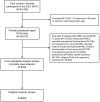Food Insecurity and Women's Choice of Reversible Contraceptives: Differential Effects by Maternal Age
- PMID: 39457316
- PMCID: PMC11507543
- DOI: 10.3390/ijerph21101343
Food Insecurity and Women's Choice of Reversible Contraceptives: Differential Effects by Maternal Age
Abstract
We investigated the relationships between food insecurity (FI) and women's choice of reversible contraceptives, overall and according to the level of method effectiveness, among partnered women of reproductive age in Nigeria. This population-based cross-sectional analysis used nationally representative data from Round 6 of the UNICEF-supported Multiple Indicator Cluster Survey (MICS) conducted in Nigeria. The sample included married or in-union women aged 15-49 years who reported a live birth in the last 2 years preceding the survey (unweighted N = 8496). Survey-weighted multivariable binomial and multinomial logistic regression analyses were performed to generate estimates of the association between FI (none, moderate, and severe) and reversible contraceptive use (overall and by method effectiveness). A Bonferroni correction was used to account for multiple testing. We stratified the models by maternal age to describe the experiences of women aged 15-24 years, 25-34 years, and 35-49 years. Overall, 6438 (74.1%) of the women in the sample experienced food insecurity (moderate, n = 2559, 30.7%; severe, n = 3879, 43.4%). In the adjusted model, we observed no statistically significant association between experiencing MFI and SFI and the use of reversible contraceptives (overall and specific) after adjustment for multiple testing. The stratified analyses showed that among women aged 25-34 years in the sample, those experiencing SFI in the past 12 months, compared to their food-secure counterparts, had significantly lower odds of reporting the use of a least effective contraceptive method (OR, 0.53; 95% CI, 0.34-0.83; p = 0.0052). However, this failed to reach the significance threshold upon adjustment for multiple testing. We found no significant association between the FI levels and use of reversible contraceptives (overall and specific) among partnered women (15-49 years) in Nigeria who were 2 years postpartum following a live birth and who were at risk of pregnancy.
Keywords: Food Insecurity Experience Scale (FIES); Multiple Indicator Cluster Survey (MICS); Nigeria; contraception; material hardship.
Conflict of interest statement
The authors declare no conflicts of interest.
Figures



Similar articles
-
Is household food insecurity associated with social attitudes accepting of physical intimate partner violence against women in Nigeria? A population-level cross-sectional study.BMJ Open. 2024 Jun 12;14(6):e082760. doi: 10.1136/bmjopen-2023-082760. BMJ Open. 2024. PMID: 38866566 Free PMC article.
-
Women's experience of unintended pregnancy and changes in contraceptive methods: evidence from a nationally representative survey.Reprod Health. 2022 Sep 1;19(1):187. doi: 10.1186/s12978-022-01492-w. Reprod Health. 2022. PMID: 36050768 Free PMC article.
-
Intimate partner violence as a factor in contraceptive discontinuation among sexually active married women in Nigeria.BMC Womens Health. 2020 Jun 17;20(1):128. doi: 10.1186/s12905-020-00990-y. BMC Womens Health. 2020. PMID: 32552670 Free PMC article.
-
Cost sharing, postpartum contraceptive use, and short interpregnancy interval rates among commercially insured women.Am J Obstet Gynecol. 2021 Mar;224(3):282.e1-282.e17. doi: 10.1016/j.ajog.2020.08.109. Epub 2020 Sep 6. Am J Obstet Gynecol. 2021. PMID: 32898503
-
Food insecurity and early childhood development among children 24-59 months in Nigeria: A multilevel mixed effects modelling of the social determinants of health inequities.PLoS One. 2025 Jan 13;20(1):e0316381. doi: 10.1371/journal.pone.0316381. eCollection 2025. PLoS One. 2025. PMID: 39804857 Free PMC article.
References
-
- Bearak J., Popinchalk A., Ganatra B., Moller A.-B., Tunçalp Ö., Beavin C., Kwok L., Alkema L. Unintended Pregnancy and Abortion by Income, Region, and the Legal Status of Abortion: Estimates from a Comprehensive Model for 1990–2019. Lancet Glob. Health. 2020;8:e1152–e1161. doi: 10.1016/S2214-109X(20)30315-6. - DOI - PubMed
MeSH terms
Substances
LinkOut - more resources
Full Text Sources
Miscellaneous

